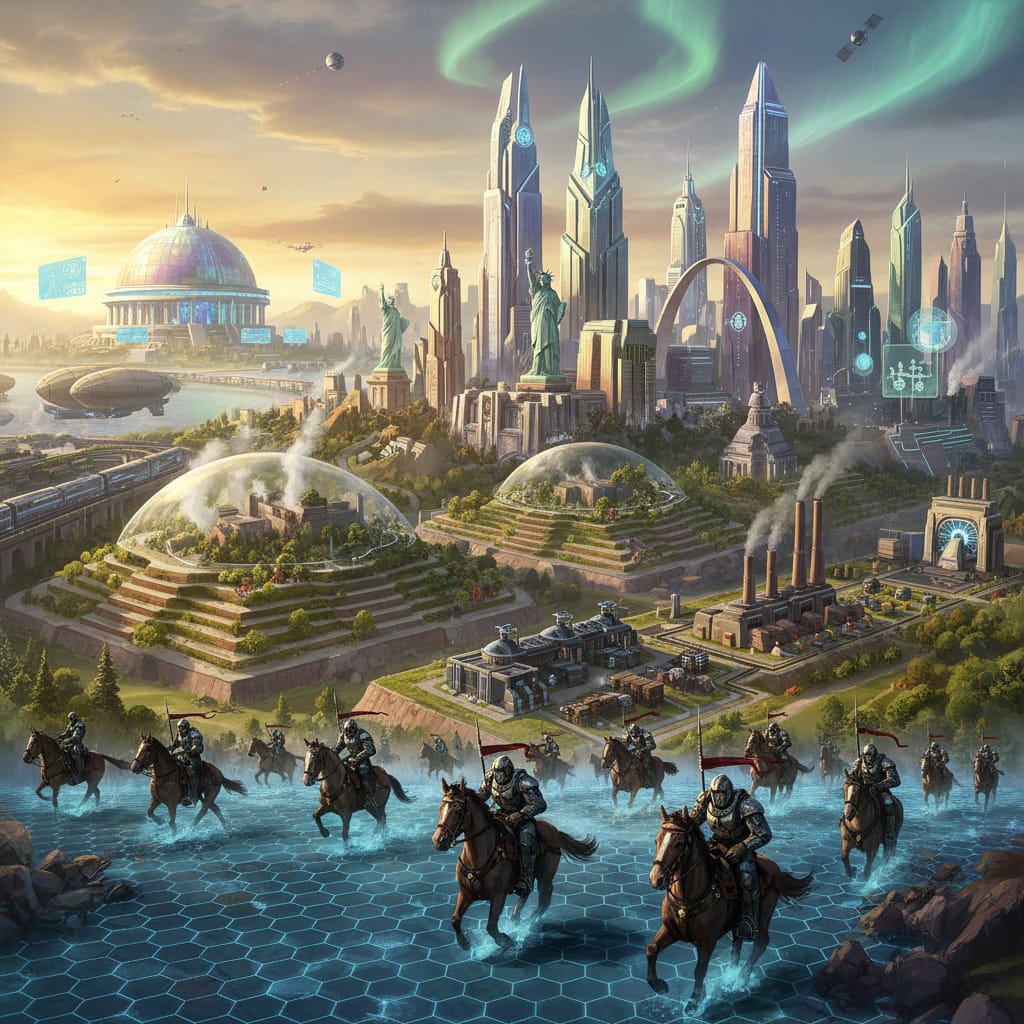America in Civilization 6 is a powerhouse of the late-game, a sleeping giant that awakens to dominate the world stage through culture, diplomacy, or force. Yet, many players find their ambitions for a glorious American empire fizzling out as the game enters its final, decisive eras. The path to victory with America is paved with potential pitfalls, subtle traps that can undo hours of careful planning. This guide provides an in-depth analysis of these common late-game blunders and offers strategic, actionable advice to navigate them, ensuring your American civilization reaches its full, world-shaping potential.
The Deceptive Lure of a Weak Early Game
One of the most significant challenges for America is its deceptively slow start. Unlike civilizations with powerful early-game unique units or bonuses, America’s true strengths lie dormant until the Modern and Atomic eras. This can lead to a sense of vulnerability and a temptation to make short-sighted decisions that cripple your late-game prospects.
Pitfall: Neglecting Early Culture and Faith
A common mistake is to focus solely on production and science in the early game, assuming that America’s late-game cultural bonuses will carry you to victory. However, this approach often leaves you with a weak foundation, unable to capitalize on your strengths when they finally come online. According to the player community, a delayed focus on culture and faith is a primary reason for late-game failure with America.
Actionable Strategy:
- Prioritize Monuments: Build a Monument in every city as early as possible. The consistent culture generation is vital for unlocking key civics and governments that will shape your empire.
- Embrace Holy Sites: Even if you are not pursuing a religious victory, Holy Sites are crucial. Faith is the currency of National Parks, a cornerstone of America’s cultural victory path. Many professional gamers suggest building at least two to three Holy Sites in your early cities to ensure a steady faith income.
- Early Government Plaza: The Government Plaza is a powerful tool for any civilization, but for America, it is essential. The bonuses it provides to culture and great person generation are invaluable for a strong mid-game transition.
Pitfall: Passive Continental Expansion
Theodore Roosevelt’s “Roosevelt Corollary” provides a +5 combat strength bonus on your home continent. Many players, however, fail to leverage this advantage, adopting a passive, defensive posture. This can result in being boxed in by aggressive neighbors, limiting your access to crucial resources and land for National Parks.
Actionable Strategy:
- Calculated Aggression: Use your continental combat bonus to your advantage. This doesn’t necessarily mean embarking on a full-scale conquest, but you should not be afraid to engage in strategic warfare to secure your borders and eliminate immediate threats. Analysis on forums shows that a well-timed early war can be the key to a successful American late-game.
- The Rough Rider Power Spike: The Rough Rider unique unit, available in the Industrial Era, is a game-changer. These powerful cavalry units, combined with your home continent combat bonus, can be used to swiftly and decisively secure your continent. A popular strategy is to use Rough Riders to eliminate any remaining continental rivals before pivoting to a peaceful cultural victory.
The National Park Puzzle: Maximizing Tourism
National Parks are the engine of America’s cultural victory machine. However, their effective use is a complex puzzle that many players fail to solve. The placement of National Parks is not arbitrary; it requires careful planning and a deep understanding of the game’s appeal mechanics.
Pitfall: Haphazard City and District Placement
One of the most irreversible mistakes is poor city and district placement. A poorly placed district can block a potential National Park site, permanently crippling your tourism potential. Many players, in their rush to build, fail to consider the long-term implications of their city planning.
Actionable Strategy:
- Plan for Appeal: From the very beginning of the game, you should be thinking about appeal. Use the appeal lens to identify potential National Park locations – vertical diamonds of four tiles with high appeal.
- Strategic District Placement: Place your districts strategically to maximize appeal in your potential National Park locations. Avoid placing districts that lower appeal, such as Industrial Zones and Encampments, near these areas.
- The Power of the Preserve: The Preserve district, while often overlooked, can be a powerful tool for boosting appeal and generating yields. A well-placed Preserve can turn a mediocre National Park site into a tourism goldmine.
Pitfall: Underestimating Faith Generation
As mentioned earlier, faith is the currency of National Parks. A common pitfall is to neglect faith generation, leaving you with a surplus of potential National Park sites but no way to create them.
Actionable Strategy:
- Consistent Faith Income: Ensure a consistent faith income throughout the game. This can be achieved through Holy Sites, religious city-states, and policy cards.
- The Oracle: The Oracle is a powerful early-game wonder that can significantly boost your great person generation, including Great Prophets. Securing an early religion can provide a substantial faith income throughout the game.
The Diplomatic Tightrope: Navigating the World Congress
While America is primarily known for its cultural prowess, it also has the potential for a Diplomatic Victory. However, this path is a tightrope walk, requiring careful management of diplomatic favor and a keen understanding of the World Congress.
Pitfall: Ignoring Diplomatic Favor
Diplomatic favor is the lifeblood of a Diplomatic Victory. Many players make the mistake of ignoring it, only to find themselves powerless in the World Congress when crucial resolutions are on the table.
Actionable Strategy:
- Become the World’s Suzerain: Focus on becoming the suzerain of as many city-states as possible. Each city-state you are the suzerain of provides a steady stream of diplomatic favor.
- Strategic Alliances: Form alliances with other civilizations. Alliances not only provide strategic benefits but also generate diplomatic favor.
- The Potala Palace: The Potala Palace is a must-build wonder for any player pursuing a Diplomatic Victory. The extra diplomatic policy slot it provides is invaluable for maximizing your diplomatic influence.
Pitfall: Misunderstanding the World Congress
The World Congress can be a confusing and unpredictable beast. Many players vote based on their immediate needs, failing to consider the long-term implications of their decisions.
Actionable Strategy:
- Predict the AI: Pay close attention to the voting patterns of the AI. With experience, you can learn to predict how they will vote on certain resolutions, allowing you to use your diplomatic favor more effectively.
- Strategic Voting: Sometimes, it is better to vote against your own interests to gain a diplomatic victory point. For example, if a resolution is proposed to give a bonus to a luxury resource you do not have, you can vote in favor of it to gain a diplomatic victory point, even if it doesn’t directly benefit you.
The Late-Game Production Trap
A strong economy and high production are the backbone of any successful civilization. However, many players, in their focus on culture and tourism, neglect their production infrastructure, leaving them unable to build key late-game wonders and units.
Pitfall: Inefficient Industrial Zone Placement
Industrial Zones are the engines of your production. However, their effectiveness is highly dependent on their placement. A poorly placed Industrial Zone is a waste of a district slot.
Actionable Strategy:
- Maximize Adjacency Bonuses: Place your Industrial Zones to maximize their adjacency bonuses. They get bonuses from mines, quarries, and other districts.
- The Power of the Factory: The Factory building provides a production bonus to all cities within a six-tile radius. A popular strategy is to create a “factory triangle” of three cities, each with a Factory, to create a massive production hub.
Pitfall: Neglecting Trade Routes
Trade routes are not just for gold. They can also be a powerful tool for boosting production. Many players fail to utilize their trade routes to their full potential.
Actionable Strategy:
- Internal Trade Routes: Use internal trade routes to send production from your high-production cities to your newer, less developed cities. This can help them get up and running much faster.
- Wisselbanken: The Wisselbanken policy card, available in the Renaissance Era, provides a significant boost to your trade routes. It is a must-have for any player looking to maximize their production.
The American Dream Realized
Playing as America in Civilization 6 is a journey of patience and planning. It is a civilization that rewards foresight and punishes short-sightedness. By avoiding these common late-game pitfalls, you can guide your American empire to its full potential, creating a cultural, diplomatic, or military powerhouse that will stand the test of time. From the early game struggles to the late-game triumphs, the American experience in Civilization 6 is a rewarding one, a true testament to the power of a well-executed long-term strategy.


